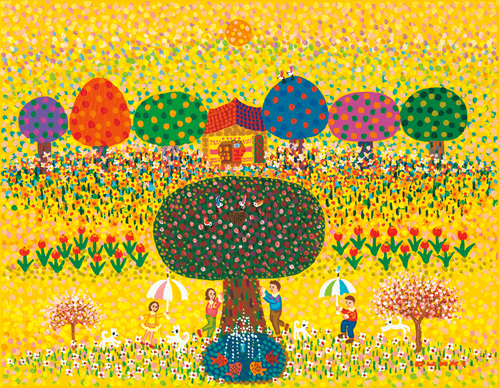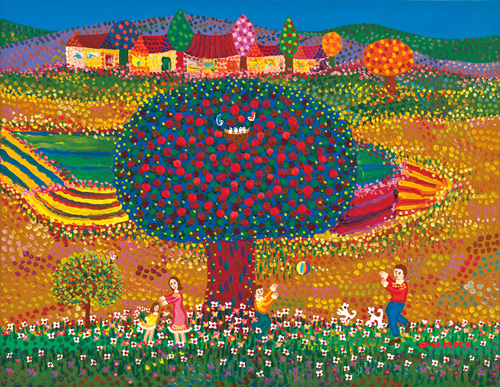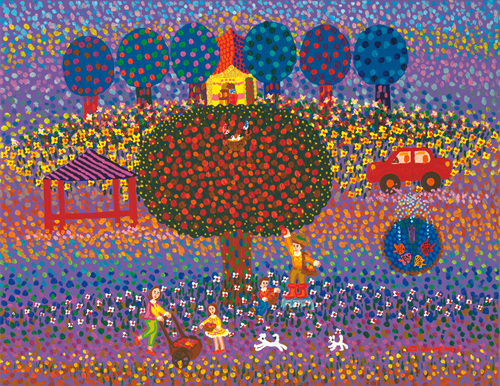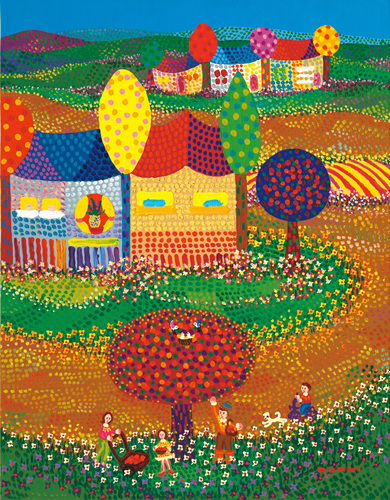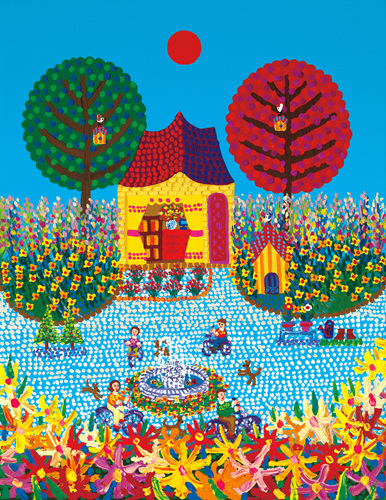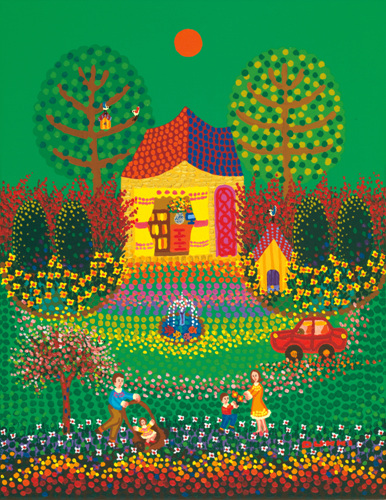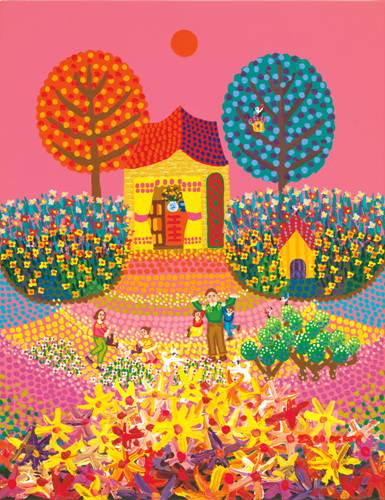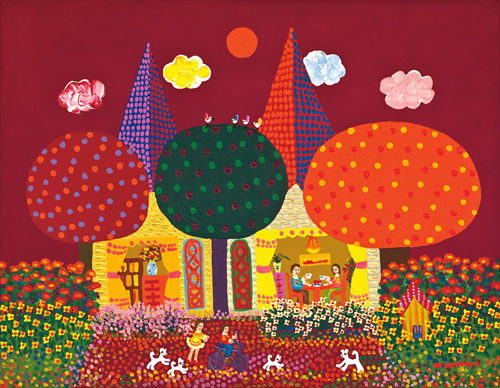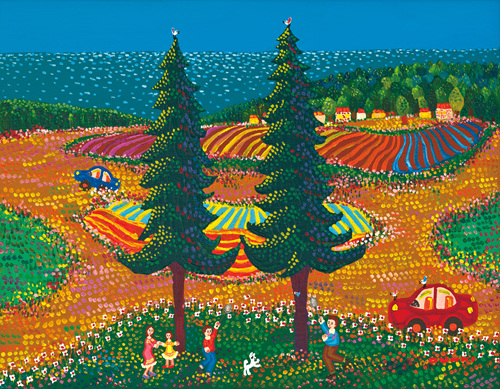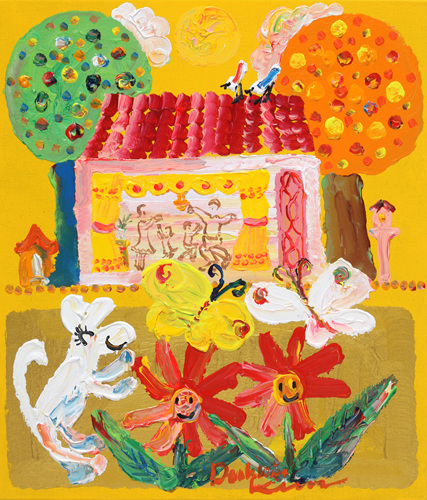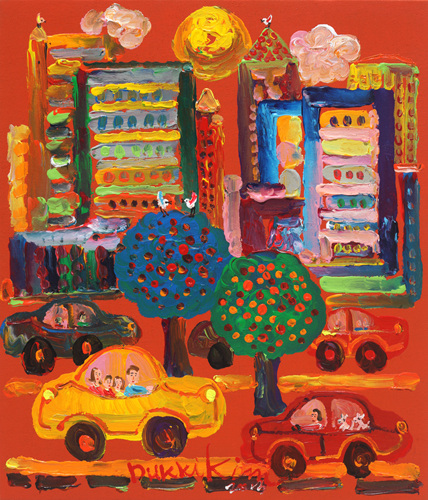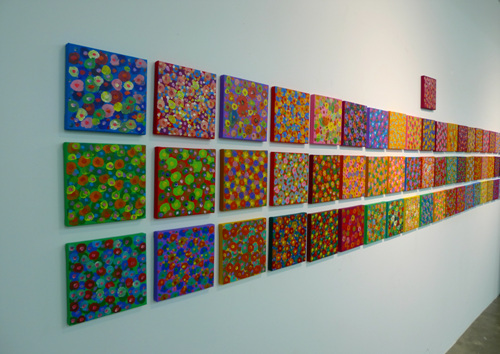Kim, Duk Ki
작은 꿈 명품 100선
Kim Dukki, A Small Dream Cultivated through Painting
“Red, white lighthouses/ stand like Generals/ and people are happy// Under the ships at anchor/ are flowing clouds/ dancing along the waves.” This is part of Kim Dukki’s poem “Spring of Chungsapo”. As in his poem, dancing waves, blue sky and lonely harbor are loudly evident in Road to Happy Village. We may momentarily be mesmerized by the exceptional scenery of rich forest, beach and country lanes. However, this is not all that there is to it. It is actually the “happiness of family” that Kim tries to convey through his remarkable scenery. The outstanding scenery is meaningful only when with family, and it is being with family that makes the surrounding environment seem so beautiful. Regarding the houses that he portray, the artist says the following.
“When home, even the busiest tasks are bound to be folded up, as we would fold up wet umbrellas inside the house during rainy seasons. Such is a home with family. Inside that home are sweet love, consolation and nastily bitter ordeal. There are bound to be times of hardship, but when I look back at the today that has become the yesterday, gratitude is almost all that I feel.” (excerpt from the artist’s notes)
For Kim, family is the reason he paints and the source of energy. The motif he has chosen is surely somewhat banal. His paintings show us that joy of life is actually very close by.
Kim’s paintings shine like the morning sunshine. Like the water crystals of a lake’s surface dancing under rays of sunlight, his paintings are full of joy and life. Of course, the secret to such joy is family. Family not only supplies subject matter to his work but also adds meaning to life. He fixes his eyes on the scene of a happy life and portrays it through his version of a simple fairytale.
Kim’s art also lets us look back at the accelerating family dissolution of today’s society. Family dissolution due to divorce causes unbearable pain on not only the couple but the children as well. According to research, stress of divorce is greater than stress of the spouse’s death and not only the divorced couple but the couple’s children suffer extreme anxiety from the dissolution of their family. Further negligence of dealing this social issue will threaten social stability. A family is not a mere group of people that share the same blood, but a community that shares love. It is worthy to remember Goethe’s words that “no matter king or farmer, the man able to find peace in his family” during times of crisis “is the happiest”. A family in which love is broken is unimaginable and the main idea of Kim’s art is that we should firmly weave our families and societies into a community of love. It is interesting that his happiness is presented as not a faraway dream, but an ongoing drama.
Happy Family Story
This exhibition, as has always been the case, is based on the “happy family” as its theme. Under the Tree, Merry Dining Table, Happy World, Road to Happy Village, etc.. Merry Dining Table depicts a family sitting around the dining table sharing a merry conversation. Inside the small house situated at the center of the screen, a family has gathered after a day’s work to share a meal and chat. The artist understands mealtime as not a literal time to obtain food but rather a time to share happiness. In the sense of sharing happiness, it is a sort of festival. It is at the dining table that laughter blooms and the day’s fatigue is washed away. Mealtimes also mean that being together is the condition of happiness. With family, giving is not a prerequisite as being together is enough. This is also true with a couple of birds, a couple of trees, a couple of fish, a couple of flowers and such. The artist positions his images in pairs to maximize the happiness of his painting.
Merry Garden is as full of excitement as a party. Not only the flowers, trees and grass decorated in fancy colors, but the puppies running around are all loud and joyful. Chirping birds and powerfully shooting water fountain are all utilized as supporting devices that boost the mood of the happy family. The grass field spotted with color dots are bustling with flowers invited to the party.
In this exhibition, Happy World, a work completed in one breath and accentuating brush strokes, is included. This piece also takes on the everyday of a family as its theme, but in terms of expression, presents free composition and pictorial delicacies. That the artist has maximized the effect of substance matter and brush strokes is also interesting.
When face to face with Kim’s paintings, it is as if they are softly talking to me about small tales of today. Most of their stories are about the day spent with family. In his paintings, there are records of everyday routines and impressions. This does not mean that the artist aims to literally convey aspects of his own life. As a painting conveys not only “facts” but “sensations”, the particular way that a fact is expressed is significant. Judging from the circumstances of the art, it seems that the artist wishes for us to share his joy and pleasure. Such hope is inside the fairytale-like portrayal of his figures, usage of bright colors and repetitions of color dots.
“When you are down and tired from a long journey, I will wave to you to come take a rest, showing you a big grand tree. If you do stop to rest under the shade of the tree, look back and feel or learn something, I shall no longer call you a fool.” (excerpt from the artist’s notes)
Kim’s art is very far from experimental or intellectual play. If a definition of the basis of his work is to be insisted upon, it could be named as “distribution of happiness” because his art deals with the very simple and practical problems in life. As Matisse had wanted his art to be the “armchair” that provides comfort, Kim seems to want his paintings to be a cozy “resting place”. A home may not be a perfect place but it is where actual love is given and received, helping us hold on to the fundamental value of a being. It is not hard to understand that the happy drama of a family is what the artist ultimately aims to convey.
His art is as clear as a cloudless sky and, in a sense, even innocent. He uses such optimistic paintings to cheer and comfort, like blowing with the bellows, those who are down and hurt. We see his happy villages or amicable families painted in bright color dots, and earn the energy to “say goodbye to the heavy, tiring, boring and dull things” and recharge our courage to live on. The artist pats people on the shoulders for support and thanks to his cheer, we once again pull ourselves together.
As such, the artist comforts people through his paintings and, as adding more sunlight onto brightness, hopes that they will become happier. His passion for such dream is as solid as rock. This is surely reminiscent of Benjamin Disraeli’s words that “man is only great when he acts from passion”. For Kim, nothing is more beautiful that the image of a happy family and not even the most entrancing spectacle of wonderful scenery is more precious than this simple beauty. The artist seems to be ordering us to “close eyes/ and look for the small truths/ hiding behind the wind”(excerpt from the artist’s notes), as the most important things are right beside us.
Seo SeongRok (Art Critic)


